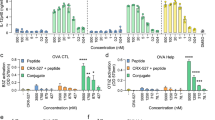Abstract
Fusion proteins consisting of the ligand-binding domain of CTLA4 covalently attached to an antigen (Ag) are potent immunogens. This fusion strategy effectively induces Ag-specific immunity both when introduced as a DNA-based vaccine and as a recombinant protein. CTLA4 is a ligand for B7 molecules expressed on the surface of antigen-presenting cells (APCs), and this interaction is critical for the fusion protein to stimulate Ag-specific immunity. We show that interaction of the fusion protein with either B7-1 or B7-2 is sufficient to stimulate immune activity, and that T cells are essential for the development of IgG responses. In addition, we demonstrate that human dendritic cells (DCs) pulsed with CTLA4–Ag fusion proteins can efficiently present Ag to T cells and induce an Ag-specific immune response in vitro. These studies provide further mechanistic understanding of the process by which CTLA4–Ag fusion proteins stimulate the immune system, and represent an efficient means of generating Ag-specific T cells for immunotherapy.







Similar content being viewed by others
References
Boczkowski D, Nair SK, Snyder D, Gilboa E (1996) Dendritic cells pulsed with RNA are potent antigen-presenting cells in vitro and in vivo. J Exp Med 184:465
Foley R, Tozer R, Wan Y (2001) Genetically modified dendritic cells in cancer therapy: implications for transfusion medicine. Transfus Med Rev 15:292
Holtl L, Rieser C, Papesh C, Ramoner R, Herold M, Klocker H, Radmayr C, Stenzl A, Bartsch G, Thurnher M (1999) Cellular and humoral immune responses in patients with metastatic renal cell carcinoma after vaccination with antigen pulsed dendritic cells. J Urol 161:777
Nestle FO, Alijagic S, Gilliet M, Sun Y, Grabbe S, Dummer R, Burg G, Schadendorf D (1998) Vaccination of melanoma patients with peptide- or tumor lysate-pulsed dendritic cells. Nat Med 4:328
Fong L, Engleman EG (2000) Dendritic cells in cancer immunotherapy. Annu Rev Immunol 18:245
Berg SF, Mjaaland S, Fossum S (1994) Comparing macrophages and dendritic leukocytes as antigen-presenting cells for humoral responses in vivo by antigen targeting. Eur J Immunol 24:1262
Carayanniotis G, Barber BH (1987) Adjuvant-free IgG responses induced with antigen coupled to antibodies against class II MHC. Nature 327:59
Guyre PM, Graziano RF, Goldstein J, Wallace PK, Morganelli PM, Wardwell K, Howell AL (1997) Increased potency of Fc-receptor-targeted antigens. Cancer Immunol Immunother 45:146
Lees A, Morris SC, Thyphronitis G, Holmes JM, Inman JK, Finkelman FD (1990) Rapid stimulation of large specific antibody responses with conjugates of antigen and anti-IgD antibody. J Immunol 145:3594
Wang H, Griffiths MN, Burton DR, Ghazal P (2000) Rapid antibody responses by low-dose, single-step, dendritic cell-targeted immunization. Proc Natl Acad Sci USA 97:847
Schjetne KW, Thompson KM, Aarvak T, Fleckenstein B, Sollid LM, Bogen B (2002) A mouse C kappa-specific T cell clone indicates that DC-SIGN is an efficient target for antibody-mediated delivery of T cell epitopes for MHC class II presentation. Int Immunol 14:1423
Biragyn A, Tani K, Grimm MC, Weeks S, Kwak LW (1999) Genetic fusion of chemokines to a self tumor antigen induces protective, T-cell dependent antitumor immunity. Nat Biotechnol 17:253
Boyle JS, Brady JL, Lew AM (1998) Enhanced responses to a DNA vaccine encoding a fusion antigen that is directed to sites of immune induction. Nature 392:408
Deliyannis G, Boyle JS, Brady JL, Brown LE, Lew AM (2000) A fusion DNA vaccine that targets antigen-presenting cells increases protection from viral challenge. Proc Natl Acad Sci USA 97:6676
Nayak BP, Sailaja G, Jabbar AM (2003) Enhancement of gp120-specific immune responses by genetic vaccination with the human immunodeficiency virus type 1 envelope gene fused to the gene coding for soluble CTLA4. J Virol 77:10850
Pulendran B, Palucka K, Banchereau J (2001) Sensing pathogens and tuning immune responses. Science 293:253
Pulendran B, Banchereau J, Maraskovsky E, Maliszewski C (2001) Modulating the immune response with dendritic cells and their growth factors. Trends Immunol 22:41
Steinman RM, Pope M (2002) Exploiting dendritic cells to improve vaccine efficacy. J Clin Invest 109:1519
Huang TH, Wu PY, Lee CN, Huang HI, Hsieh SL, Kung J, Tao MH (2000) Enhanced antitumor immunity by fusion of CTLA4 to a self tumor antigen. Blood 96:3663
Rohrbach F, Weth R, Kursar M, Sloots A, Mittrucker HW, Wels WS (2005) Targeted delivery of the ErbB2/HER2 tumor antigen to professional APCs results in effective antitumor immunity. J Immunol 174:5481
Oaks MK, Hallett KM, Penwell RT, Stauber EC, Warren SJ, Tector AJ (2000) A native soluble form of CTLA4. Cell Immunol 201:144
Borriello F, Sethna MP, Boyd SD, Schweitzer AN, Tivol EA, Jacoby D, Strom TB, Simpson EM, Freeman GJ, Sharpe AH (1997) B7-1 and B7-2 have overlapping, critical roles in immunoglobulin class switching and germinal center formation. Immunity 6:303
Freeman GJ, Borriello F, Hodes RJ, Reiser H, Hathcock KS, Laszlo G, McKnight AJ, Kim J, Du L, Lombard DB (1993) Uncovering of functional alternative CTLA4 counter-receptor in B7-deficient mice. Science 262:907
Finck BK, Linsley PS, Wofsy D (1994) Treatment of murine lupus with CTLA4Ig. Science 265:1225
Pearson TC, Alexander DZ, Winn KJ, Linsley PS, Lowry RP, Larsen CP (1994) Transplantation tolerance induced by CTLA4–Ig. Transplantation 57:1701
Chaplin PJ, De Rose R, Boyle JS, McWaters P, Kelly J, Tennent JM, Lew AM, Scheerlinck JP (1999) Targeting improves the efficacy of a DNA vaccine against Corynebacterium pseudotuberculosis in sheep. Infect Immun 67:6434
Author information
Authors and Affiliations
Corresponding author
Additional information
Dhanalakshmi Chinnasamy and Matt Tector contributed equally to this work
Rights and permissions
About this article
Cite this article
Chinnasamy, D., Tector, M., Chinnasamy, N. et al. A mechanistic study of immune system activation by fusion of antigens with the ligand-binding domain of CTLA4. Cancer Immunol Immunother 55, 1504–1514 (2006). https://doi.org/10.1007/s00262-006-0153-7
Received:
Accepted:
Published:
Issue Date:
DOI: https://doi.org/10.1007/s00262-006-0153-7




